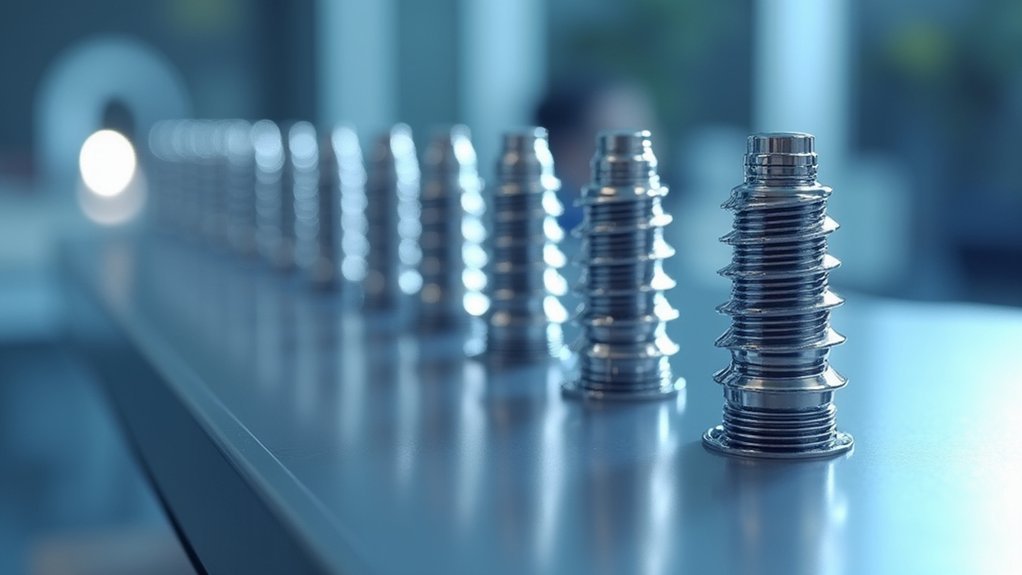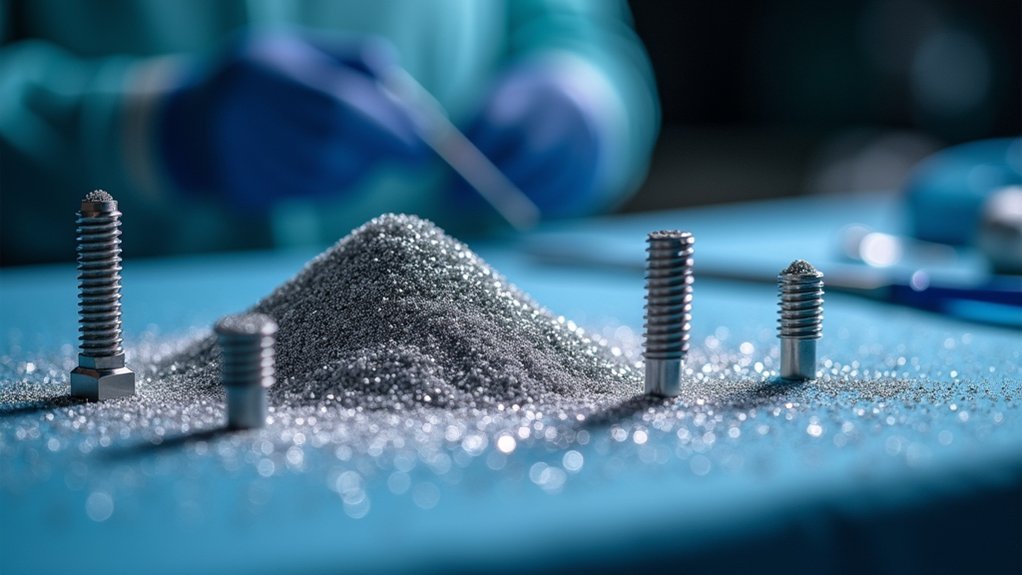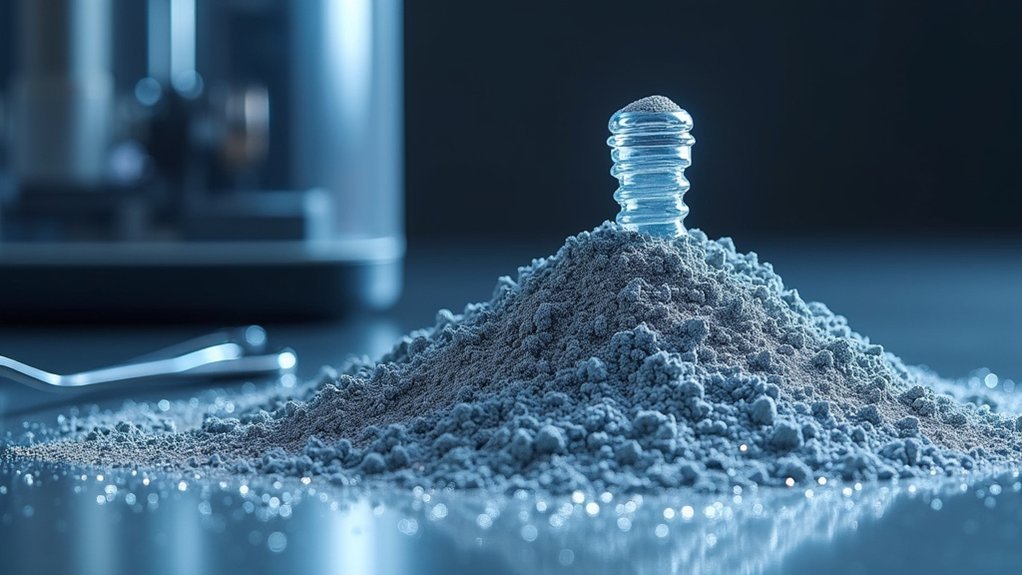You’ll choose cobalt chrome powder for medical 3D printing because it offers exceptional biocompatibility that minimizes tissue reactions and prevents inflammation in critical implants. The material’s superior corrosion resistance, with rates less than 0.1 mm/year, guarantees long-term stability in body fluids. Its impressive mechanical properties—1100 MPa tensile strength and 60 HRC hardness—make it perfect for load-bearing applications like hip and knee replacements. The powder’s ideal characteristics enable precise DMLS manufacturing for patient-specific solutions that’ll transform your medical device capabilities.
Superior Biocompatibility Properties of Cobalt Chrome Alloys

When you’re developing medical implants that must integrate seamlessly with human tissue, cobalt chrome alloys stand out as exceptional materials due to their superior biocompatibility properties.
You’ll find that these alloys minimize adverse reactions when placed in the human body, making them ideal for critical applications like hip and knee replacements.
The biocompatibility of cobalt chrome stems from its remarkable corrosion resistance.
You’ll benefit from the passive oxide layer that forms naturally on the surface, protecting the implant from bodily fluids and preventing harmful ion release. This corrosion resistance directly translates to enhanced implant longevity and reliability.
You won’t need to worry about tissue rejection or inflammation, as cobalt chrome’s compatibility with human physiology has been proven through decades of successful clinical use in orthopedic applications.
Exceptional Corrosion Resistance in Physiological Environments
When you’re selecting materials for medical implants, cobalt chrome’s exceptional corrosion resistance stems from its passive oxide layer protection that forms naturally in physiological environments.
You’ll find this chromium oxide barrier guarantees your biocompatible implant performance remains consistent even when exposed to corrosive body fluids over extended periods.
You can rely on cobalt chrome’s long-term material stability to maintain structural integrity and functionality throughout the implant’s lifespan in the human body.
Passive Oxide Layer Protection
Upon exposure to oxygen, cobalt chrome alloys spontaneously form a passive oxide layer composed primarily of chromium oxide, creating an exceptional barrier against corrosion in the body’s harsh physiological environment.
This protective layer shields your implants from degradation caused by bodily fluids, ensuring long-term reliability and performance.
The passive oxide layer’s corrosion resistance prevents metal ion release that could trigger adverse biological reactions and implant failure.
Research demonstrates that cobalt chrome implants exhibit corrosion rates less than 0.1 mm/year in physiological conditions, proving their suitability for permanent implantation.
This remarkable protection allows your medical devices to maintain mechanical properties and structural integrity despite constant exposure to corrosive bodily fluids, making cobalt chrome indispensable for durable, biocompatible medical applications.
Biocompatible Implant Performance
Beyond protecting against degradation, this oxide barrier directly facilitates cobalt chrome’s outstanding biocompatible performance in your body’s complex internal environment. The material’s exceptional biocompatibility minimizes adverse reactions while maintaining structural integrity throughout long-term implantation. You’ll benefit from cobalt chrome’s superior wear resistance, which guarantees your implants withstand daily stresses without compromising functionality.
| Performance Aspect | Benefit |
|---|---|
| Corrosion Resistance | Maintains implant integrity in body fluids |
| Mechanical Strength | Withstands daily activity stresses |
| Wear Resistance | Prevents degradation over time |
| Biocompatibility | Reduces risk of adverse reactions |
Studies demonstrate that cobalt chrome implants retain their mechanical properties even after extended exposure to physiological environments, making them reliable solutions for orthopedic and dental applications requiring exceptional longevity.
Long-Term Material Stability
As your cobalt chrome implant settles into its physiological environment, the material’s exceptional long-term stability becomes its defining characteristic.
The high chromium content creates a robust passive oxide layer that delivers outstanding corrosion resistance against bodily fluids and harsh physiological conditions. This protective barrier guarantees your implant won’t degrade over time, greatly reducing failure risks and maintaining structural integrity for decades.
- Passive oxide formation – Chromium content automatically generates a self-healing protective layer
- Bodily fluid resistance – Withstands continuous exposure to saliva, blood, and other corrosive biological environments
- Minimal tissue reactions – Biocompatible surface prevents adverse inflammatory responses
- Wear durability – Maintains performance under high-stress mechanical loading conditions
This stability makes cobalt chrome powder ideal for manufacturing permanent medical devices through 3D printing.
High Strength-to-Weight Ratio for Load-Bearing Implants
When you’re designing load-bearing implants, you’ll find that cobalt chrome’s exceptional strength-to-weight ratio delivers superior structural performance that can handle tensile strengths up to 1100 MPa while maintaining a lightweight profile.
You can create implants with ideal weight distribution by leveraging the material’s 7.90 g/cm³ density, ensuring your patients won’t experience unnecessary burden from heavy hardware.
This combination allows you to manufacture complex, patient-specific designs that distribute loads effectively while maintaining the mechanical integrity essential for long-term implant success.
Superior Structural Performance
While traditional materials often force you to choose between strength and weight, cobalt chrome powder eliminates this compromise in medical 3D printing applications.
You’ll achieve remarkable structural performance with high tensile strength reaching 1100 MPa, enabling your implants to withstand significant loads without adding unnecessary weight. The medical industry benefits from this alloy’s density of just 7.90 g/cm³, creating patient-friendly implants that maintain structural integrity.
Your cobalt chrome components deliver:
- Exceptional hardness up to 60 HRC for outstanding wear resistance
- Superior fatigue resistance preventing failure under repetitive stress cycles
- Reliable performance at elevated temperatures matching physiological conditions
- Ideal strength-to-weight balance reducing patient discomfort while guaranteeing durability
This combination guarantees your 3D printed implants perform reliably throughout their intended lifespan.
Optimal Weight Distribution
Strategic weight distribution becomes essential when you’re designing load-bearing implants that patients will rely on for years. Cobalt chrome’s high strength-to-weight ratio makes it exceptionally suited for these demanding applications.
With a density of 7.90 g/cm³, you’ll achieve lightweight properties without compromising structural integrity.
The mechanical properties are impressive – 1100 MPa tensile strength and 600 MPa yield strength provide reliable performance under stress.
When you’re 3D printing with cobalt chrome powder, you can create complex geometries that optimize weight distribution throughout the implant. This means you’ll reduce unnecessary bulk while maintaining robust support where it’s needed most.
The result is enhanced patient comfort and mobility, as the implant won’t add excessive weight while delivering the structural performance required for long-term success.
Optimal Powder Characteristics for Medical Grade 3D Printing

Precision defines every aspect of cobalt chrome powder selection for medical-grade 3D printing applications.
You’ll need specific particle sizes like 45/10µm or 38/10µm to achieve ideal flowability and surface finish. CoCr powder’s chemical composition, including UNS R31537 and ISO 5832-4 standards, delivers tensile strength up to 1100 MPa with excellent corrosion resistance for biocompatible implants.
Metal laser sintering technology requires uniform crystal grain structures to enhance mechanical properties and guarantee implant durability.
You’ll achieve dense, high-quality layers through precise powder melting control during the DMLS process.
Key characteristics for medical-grade applications:
- Particle size distribution of 45/10µm or 38/10µm for superior flowability
- Chemical composition meeting UNS R31537 standards
- Fine, uniform grain structure for enhanced strength
- Compatibility with stress relief post-processing requirements
Direct Metal Laser Sintering Process for Medical Devices
You’ll find that DMLS transforms cobalt chrome powder into precision medical devices by using a laser to selectively melt powder layers, creating complex geometries impossible with traditional manufacturing.
When you’re producing medical implants, this process delivers high-density parts with mechanical properties matching wrought materials while enabling patient-specific customization.
You must implement rigorous quality control standards throughout the DMLS workflow to guarantee each medical device meets strict regulatory requirements and performs reliably in clinical applications.
DMLS Process Overview
When manufacturing medical devices requires both precision and biocompatibility, Direct Metal Laser Sintering (DMLS) emerges as a transformative additive manufacturing technology that’s revolutionizing how you’ll produce cobalt chrome implants.
DMLS uses a high-powered laser to selectively fuse CoCr alloys powder particles layer by layer, creating highly dense components with complex geometries. You’ll benefit from this process’s ability to minimize material waste while maximizing design flexibility for patient-specific implants.
- Layer-by-layer construction: Laser selectively fuses cobalt chrome powder particles to build complex three-dimensional structures
- Sustainable manufacturing: Only uses exact powder amounts needed, reducing material waste considerably
- Patient-specific customization: Creates optimized implant structures that enhance fit and functionality for individual patients
- Enhanced post-processing: Heat treatment and surface finishing further improve mechanical properties and biocompatibility
Medical Device Applications
Innovation in orthopedic surgery has reached new heights through DMLS technology’s ability to transform cobalt chrome powder into life-changing medical devices.
You’ll find metal laser sintering particularly valuable for creating knee and hip replacements that offer superior biocompatibility and mechanical strength. This technology enables you to produce patient-specific implants with complex geometries that wouldn’t be possible through traditional manufacturing methods.
The medical field benefits tremendously from cobalt chrome’s exceptional properties, including high corrosion resistance and wear resistance.
You can achieve rapid prototyping while minimizing material waste, greatly reducing lead times for custom implants.
Post-processing techniques like heat treatment and surface finishing guarantee your final products meet stringent medical standards while delivering enhanced fit and functionality for individual patients.
Quality Control Standards
Rigorous quality control standards govern every aspect of the DMLS process when producing medical devices from cobalt chrome powder.
You’ll find that stringent inspection certificates like EN 10204, Type 3.1 validate both material properties and manufacturing processes. The layer-by-layer construction guarantees dimensional accuracy that’s critical for implant fit and functionality.
Quality control standards encompass thorough testing protocols:
- Extensive powder testing validates material composition and purity before processing
- In-process monitoring tracks laser parameters and build conditions continuously
- Post-production inspection verifies dimensional accuracy using coordinate measuring machines
- Final certification guarantees compliance with ISO 13485 and ASTM F75 medical-grade standards
You’re assured that every component meets biocompatibility requirements while maintaining the corrosion resistance essential for medical applications through these rigorous protocols.
Post-Processing Techniques for Enhanced Surface Quality
After your cobalt chrome parts emerge from the 3D printer, you’ll need to implement strategic post-processing techniques to achieve the surface quality medical applications demand.
Heat treatment becomes your first priority, enhancing mechanical properties while relieving residual stresses that could compromise implant durability.
You’ll want to address surface roughness through shot peening or polishing processes, creating smoother surfaces that promote better biocompatibility. These finishing techniques directly impact how well your implants integrate with patient tissue.
Machining and grinding help you achieve tight tolerances and precise dimensions, ensuring perfect anatomical fit.
Don’t overlook stress relief processes post-depowdering—they can take 30 minutes to several hours depending on part complexity.
Effective post-processing dramatically improves fatigue resistance and mechanical performance, essential for implants facing dynamic loads.
Precision Manufacturing of Complex Geometrical Structures

When you’re designing medical implants with intricate internal channels, lattice structures, or patient-specific anatomical contours, cobalt chrome powder transforms these complex visions into manufacturable realities.
Through metal laser sintering and similar additive manufacturing processes, you can achieve precision manufacturing that traditional machining simply can’t deliver.
The fine, uniform crystal grain structure guarantees your 3D printed parts maintain exceptional mechanical properties throughout complex geometries.
With cobalt chrome’s impressive tensile strength of approximately 1100 MPa, your intricate designs won’t compromise performance under demanding physiological conditions.
- Layer-by-layer construction eliminates traditional machining constraints for complex internal features
- Patient-specific implants match exact anatomical requirements for improved surgical outcomes
- Minimal material waste during rapid prototyping accelerates custom implant development
- High-stress orthopedic applications benefit from superior strength in complex geometrical structures
Material Properties Critical for Long-Term Implant Performance
While complex geometries showcase cobalt chrome’s manufacturing versatility, the material’s inherent properties dictate whether your implants will perform reliably over decades of physiological stress.
| Property | Value | Clinical Impact |
|---|---|---|
| Tensile Strength | 1100 MPa | Resists fracture under load |
| Yield Strength | 600 MPa | Maintains shape integrity |
| Hardness | 60 HRC | Prevents wear damage |
| Corrosion Resistance | Passive oxide layer | Protects against body fluids |
| Biocompatibility | Minimal tissue reaction | Reduces inflammation risk |
You’ll benefit from cobalt chrome’s exceptional corrosion resistance through its passive oxide layer formation, protecting implants from harsh physiological environments. The material’s biocompatibility guarantees minimal adverse tissue reactions during prolonged contact. Additionally, 3D printing creates fine, uniform crystal grain structures that enhance mechanical properties, delivering the durability your patients need for successful long-term outcomes.
Regulatory Compliance and Quality Assurance Standards
Before you can manufacture cobalt chrome implants for patient use, you must navigate a complex web of regulatory standards that govern every aspect of production, from raw material specifications to final device approval.
Manufacturing cobalt chrome implants requires navigating complex regulatory standards governing every production aspect from raw materials to final device approval.
You’ll need ISO 13485 compliance to establish quality management systems that consistently meet medical device requirements. The metal properties of your cobalt chrome powder must conform to ASTM F75 and F1537 standards, which specify material characteristics and testing protocols for medical applications.
Key regulatory requirements include:
- FDA approval for confirming safety and effectiveness in surgical applications
- CE certification for European market access and compliance with health standards
- ASTM standards compliance for material properties and testing requirements
- MOHAP approvals for UAE healthcare system integration and local regulation adherence
Cost-Effective Production of Patient-Specific Implants
Although traditional manufacturing methods require expensive tooling and lengthy lead times for custom implants, cobalt chrome 3D printing transforms the economics of patient-specific medical devices.
You’ll achieve cost-effective production by eliminating material waste through additive manufacturing, using only the necessary amount of powder for each custom design. Metal laser sintering technologies like DMLS enable rapid prototyping, delivering custom implants within 2-3 weeks while reducing overall costs.
You’ll benefit from cobalt chrome’s biocompatibility and high strength, creating durable implants that require fewer replacements and lower long-term healthcare expenses.
The technology allows you to consolidate multiple components into single printed implants, reducing assembly costs and complexity. Additionally, you can produce intricate, optimized geometries that eliminate multiple machining processes, enhancing both performance and cost efficiency.
Wear Resistance Performance in Joint Replacement Applications
When joint replacement implants endure millions of loading cycles throughout a patient’s lifetime, cobalt chrome’s exceptional wear resistance becomes critical for long-term success.
You’ll find that this material’s remarkable durability stems from its high hardness rating of up to 60 HRC, which dramatically extends implant lifespan in demanding load-bearing environments.
Through Metal Additive Manufacturing, you can achieve optimized geometries that further enhance wear resistance while minimizing contact stresses.
- Superior hardness: Cobalt chrome reaches 60 HRC, providing exceptional resistance to mechanical wear
- Biocompatible performance: Maintains structural integrity in harsh physiological conditions without generating harmful debris
- Extended longevity: Preserves mechanical properties after prolonged exposure to bodily environments
- Optimized design: 3D printing enables complex geometries that reduce stress concentrations and improve wear performance
Thermal and Mechanical Properties Under Body Conditions
Since cobalt chrome implants must function reliably within the dynamic environment of the human body, understanding their thermal and mechanical behavior under physiological conditions becomes essential for successful clinical outcomes.
You’ll find that cobalt chrome’s high tensile strength of 1100 MPa and 600 MPa yield strength guarantee your implants withstand the repetitive stresses of daily movement. The material’s 20% elongation at break allows it to absorb dynamic loads without fracturing.
When laser-based 3D printing creates the fine, uniform crystal grain structure, you get enhanced mechanical performance at body temperature. The passive oxide layer formation provides excellent corrosion resistance, maintaining structural integrity throughout the implant’s lifespan under varying physiological conditions.
Advanced Manufacturing Capabilities for Custom Medical Solutions
Beyond these impressive material characteristics, cobalt chrome powder releases unprecedented manufacturing flexibility that transforms how you approach custom medical device production.
You’ll access rapid prototyping capabilities that compress traditional timelines from months to just 2-3 weeks, revolutionizing patient care delivery.
The layer-by-layer construction process enables you to create complex geometries that perfectly match individual anatomical requirements, something impossible with conventional manufacturing methods.
You’re no longer constrained by standard implant sizes or shapes.
- Patient-specific designs tailored to unique anatomical features through advanced 3D printing technologies
- Complex internal structures and lattice patterns that optimize weight while maintaining structural integrity
- Rapid manufacturing timelines reducing production from months to weeks for custom solutions
- Superior mechanical properties delivering tensile strength up to 1100 MPa with excellent corrosion resistance
Frequently Asked Questions
What Is Cobalt Chrome Used For?
You’ll find cobalt chrome used in orthopedic implants like hips and knees, dental crowns and bridges, spinal devices, and customized medical components where you need exceptional strength, durability, and biocompatibility.
Can You 3D Print Cobalt Chrome?
You can 3D print cobalt chrome using Direct Metal Laser Sintering or Selective Laser Melting techniques. These methods create dense, durable parts with excellent mechanical properties, making them perfect for medical implants and high-stress applications.
Why Is Cobalt Chromium Used for Implants?
You’ll find cobalt chromium’s used for implants because it’s highly biocompatible, corrosion-resistant, and incredibly strong. Its wear resistance and non-magnetic properties make it perfect for long-term joint replacements and dental applications.
What Material Is Frequently Used in 3D Printing of Medical Implants?
You’ll find cobalt chrome alloys are frequently used in 3D printing medical implants. They’re chosen because you get excellent biocompatibility, corrosion resistance, and high mechanical strength needed for load-bearing orthopedic applications.





Leave a Reply